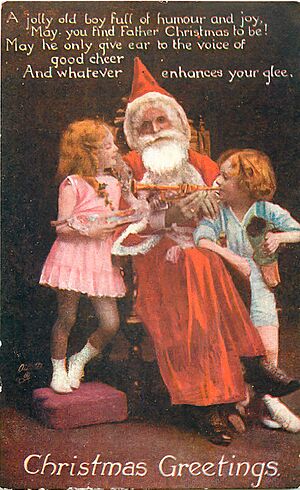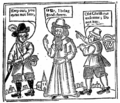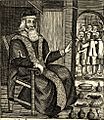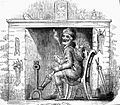Father Christmas facts for kids

Father Christmas is the traditional English name for the person who represents Christmas. Today, he is known for bringing gifts and is often seen as the same as Santa Claus around the world. However, Father Christmas actually comes from much older English traditions that were not originally connected to gift-giving. The familiar look of Father Christmas we know today became popular in the late Victorian period. But people had been imagining Christmas as a person for hundreds of years before that.
Contents
The History of Father Christmas
Early Christmas Personifications
People in England first started describing Christmas as a person in the 1400s. The character of Father Christmas himself first appeared in the mid-1600s. This was after the English Civil War. During this time, the government was controlled by a group called the Puritans. They decided to get rid of Christmas because they thought it was too much like Catholic traditions. They even banned many old Christmas customs.
Father Christmas as a Symbol of Tradition
People who supported the King, called Royalists, used Old Father Christmas as a symbol. They linked him to the "good old days" of feasting and fun. He became a sign of the old traditions they wanted to keep. After the King returned to power in 1660, Father Christmas became less well-known.
Father Christmas in Folk Plays
During the late 1700s and into the 1800s, Father Christmas's character was kept alive. He appeared in traditional folk plays, which later became known as mummers plays. In these plays, he was often a character who brought good cheer and reminded people of old customs.
Victorian Changes and Gift-Giving
Until the Victorian era, Father Christmas was mostly about adult parties and having a good time. He didn't have a special connection with children or giving presents. He wasn't known for visiting houses at night, leaving gifts in stockings, or coming down chimneys.
However, as Christmas in the Victorian times changed, it became more focused on children and family. Father Christmas then started to become a bringer of gifts. The popular American idea of Santa Claus arrived in England in the 1850s. Father Christmas began to take on many of Santa's features. By the 1880s, these new customs were common. The night visitor was sometimes called Santa Claus and sometimes Father Christmas. He was often shown wearing a long red hooded gown with white fur trim.
Any small differences between Father Christmas and Santa Claus mostly disappeared in the early 1900s. Today, most dictionaries say that the names Father Christmas and Santa Claus mean the same thing.
Images for kids
-
A Merry England vision of Old Christmas 1836
-
'Ghost of Christmas Present' in Charles Dickens's A Christmas Carol 1843.
-
Father Christmas cartoon, Punch, Dec 1919
-
Father Christmas Packing 1931, as imagined in a private letter by JRR Tolkien, published in 1976
-
A hunchback Old Father Christmas in an 1836 play with long robe, holly wreath and staff.
-
An 1852 play. The Old Father Christmas character is on the far left.



















